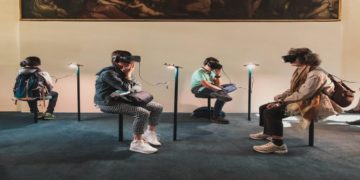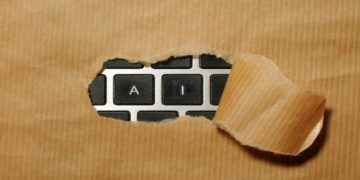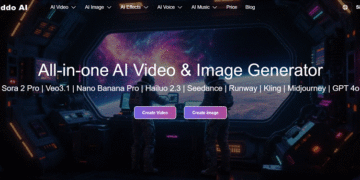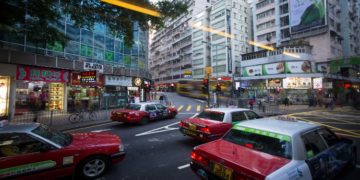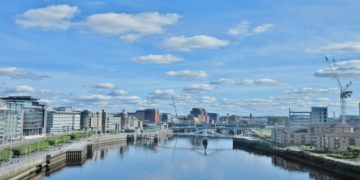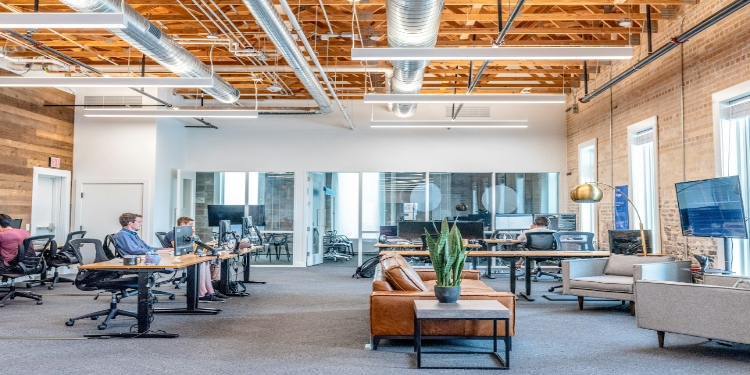The modern office has evolved far beyond its simple aesthetic roots to the extent that today’s workplaces are designed more as performance tools than simple buildings. As digital and physical spaces merge, the office has become an adaptive ecosystem: responsive, data-driven, and built around the people who use it.
Here are five key trends reshaping how the modern workspace looks, feels, and functions.
1. Human-Centric Lighting Design
Lighting is no longer just about visibility. It’s about health and performance. Modern Human-Centric Lighting systems use networked LED technology to automatically adjust colour temperature and brightness throughout the day, mirroring natural daylight. This helps regulate employees’ circadian rhythms, boosting alertness during working hours and promoting relaxation later in the day.
Traditional fluorescent panels are being replaced with discreet ceiling-mounted LED profiles that create an even, glare-free glow. These architectural fixtures blend seamlessly into the ceiling grid, providing both visual comfort and aesthetic elegance. By integrating tunable light into everyday environments, businesses are transforming lighting into a wellbeing tool that enhances focus, reduces fatigue, and reinforces natural balance.
2. Seamless Collaboration Hubs (Frictionless AV)
The traditional meeting room is quickly becoming obsolete. Modern offices prioritise “frictionless collaboration,” where technology disappears into the design. Displays, microphones, and cameras are now integrated directly into walls or furniture, often concealed behind acoustic panels or fabric finishes.
Wireless presentation systems and unified video platforms enable teams to connect instantly from any device, eliminating wasted minutes spent troubleshooting. This clean, cable-free approach not only looks more sophisticated but also reflects how collaboration should feel: seamless, efficient, and human.
3. Integrated Power and Modular Furniture Systems
In today’s flexible workplaces, people move constantly between quiet focus zones, collaborative spaces, and informal breakout areas. To support this activity-based working model, furniture has evolved into a dynamic delivery system for power and connectivity.
Thoughtful ergonomic and design considerations directly influence productivity and comfort. Desks and modular seating now feature integrated power outlets, wireless charging pads, and built-in data ports, freeing employees from fixed wall sockets. With reconfigurable furniture and adaptable layouts, businesses can respond quickly to changing team needs, creating a workspace that is as mobile as the people within it.
4. Acoustic Technology and Sound Zoning
Open-plan layouts may encourage collaboration, but they also bring one persistent challenge: noise. The latest office designs combine materials and technology to actively manage the soundscape. Acoustic panels made from felt, cork, and recycled textiles absorb unwanted echo, while sound-masking systems emit gentle background noise that neutralises distraction.
This approach allows designers to create “invisible sound zones,” ensuring that lively brainstorming areas don’t interfere with focused solo work. The result is a more balanced, productive environment where employees can collaborate and concentrate comfortably within the same space.
5. The Sensor Layer for Data-Driven Design
At the frontier of office innovation lies the invisible “sensor layer.” Tiny IoT (Internet of Things) sensors collect real-time, anonymous data on occupancy, air quality, temperature, and movement. This transforms the office into a living, learning system.
Facility managers can use these insights to fine-tune climate control, automate lighting, or identify underused areas. Over time, these data patterns help inform smarter refurbishments and reduce energy waste, ensuring spaces evolve in line with how people actually use them.
David Prior
David Prior is the editor of Today News, responsible for the overall editorial strategy. He is an NCTJ-qualified journalist with over 20 years’ experience, and is also editor of the award-winning hyperlocal news title Altrincham Today. His LinkedIn profile is here.

